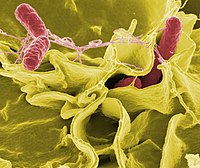
Photo from wikipedia
Genotypic based detection methods using specific target sites in the pathogen genome can complement phenotypic identification. We report the development of species-specific antisense peptide nucleic acid (PNA) combined with selective… Click to show full abstract
Genotypic based detection methods using specific target sites in the pathogen genome can complement phenotypic identification. We report the development of species-specific antisense peptide nucleic acid (PNA) combined with selective and differential enrichment growth conditions for Salmonella treatment and detection. An antisense PNA oligomer targeting the Salmonella ftsZ gene and conjugated with a cell-penetrating peptide ((KFF)3K) was exploited to probe bacteria cultured in three different growth media (Muller Hinton broth (MHB), Rappaport-Vassiliadis Soya Peptone Broth (RVS, Oxoid), and in-house modified Rappaport-Vassiliadis Soya Peptone Broths (mRVSs). Also, water and milk artificially contaminated with bacteria were probed. Antisense PNA provided detectable changes in Salmonella growth and morphology in all media and artificially contaminated matrices except RVS. Salmonella was detected as elongated cells. On the contrary, treated Escherichia coli did not elongate, providing evidence of differentiation and selectivity for Salmonella. Similarly, Salmonella probed with mismatched PNAs did not elongate. Antisense oligomers targeted ftsZ mRNA in combination with selective growth conditions can provide a detection strategy for viable Salmonella in a single reaction, and act as a potential tool for bacteria detection in real food and environmental samples.
Journal Title: Heliyon
Year Published: 2020
Link to full text (if available)
Share on Social Media: Sign Up to like & get
recommendations!